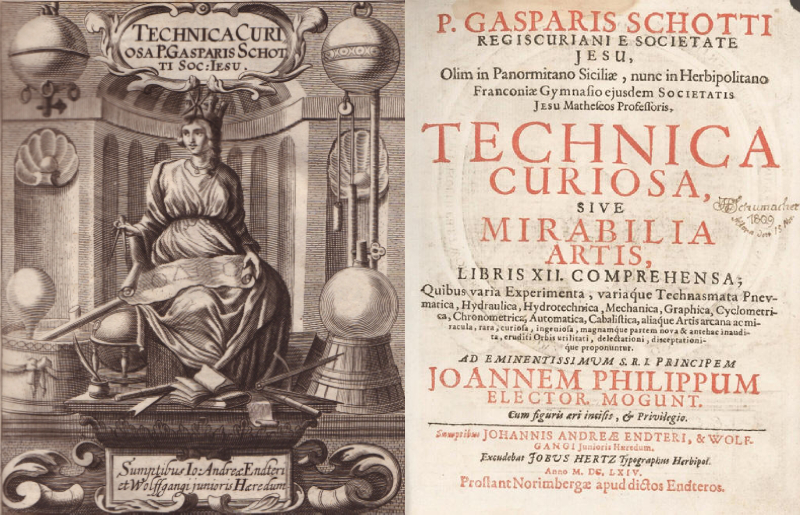
KTU Library’s Virtual Exhibition

Interesting Technical or Scientific Miracles, described in 12 books:
for the benefit, pleasure and consideration of educated world, they provide various experiments and various tricks pneumatics, hydraulics, hydrotechnics, mechanics, graphics, cyclometrics, automatics, kabalistics and other scientific secrets and miracles, rare, interesting, inventive and mainly new and unheard of;
for His Eminence S. R. I. Duke John Philip, Elector of Mainz. With copper carvings and a privilege. For the funds of successors Johann Andreas Endter and Wolfgang Junior. Printed by Jobs Hertz, printer of Wurzburg, in 1664. Published in Nurnberg at the above-mentioned Endteres.
The book provides useful knowledge and descriptions of scientific and mechanical technology devices. First chapters provide descriptions of aerostatics research by Guericke and Bouyle and tractate “Mirabilia chronometrica” provides first universal classification of gear teeth.
Translated by VDU lecturer Sigitas Lūžys.
Biography of Gaspar Schott
Gaspar Schott (1608-1666) (German Kaspar Schott, Latin Gaspare Schotto) – German Jesuit and scientist, who specialized in physics, mathematics and other areas.
G. Schott was born Königshof, close to Würzburg. It is implied, although not known, that he acquired an early education in Jesuit College in Würzburg. In 1627 nineteen-year-old G. Schott joined Society of Jesus and on 6 November 1629 he was admitted to Würzburg University for three-year philosophy studies with Athanasius Kircher (1602-1680), continuing education obligatory for Jesuit seminarians.
In 1631 G. Schott travelled to Jesuit seminary of Tournai (Belgium), in 1633 he moved to Sicily where he continued studies of theology, philosophy and mathematics in Palermo until 1638. In 1637 he was ordained a priest. G. Schott remained in Sicily for almost twenty years, was a lecturer in various Jesuit Colleges in Sicily, however mostly in Palermo, he spent two years in Trapani.
In 1652 he moved to Rome College, where he worked with Athanasius Kircher. During the next 2,5 years G. Schott worked as an assistant and collected material for the works that were published later. In 1655 he returned to Germany, first to Mainz, later to Würzburg, where he lived for the rest of his life. He taught mathematics and physics in Würzburg Gymnasium. The return of G. Schott was partially motivated by the wish of Jesuit superiors to “mollify” the Archbishop of Mainz Johann von Schonborn, the relationship with whom had been strained. G. Schott visited Rome in 1661 and 1664, submitted his application to teach mathematics in Rome Jesuit College, but it was declined. Instead, he was offered a position of Head of Heiligenstadt College, which he declined, thinking that he was not suitable for administrative work and due to health issues. G. Schott died at the age of 58.
Main works
G. Schott did not perform many original discoveries. It is more of a compilation of presentations, articles, reviews of read books and repeated experiments. G. Schott is best known for his works in the areas of hydraulics and mechanical tools. Main works:
Mechanica Hydraulico-Pneumatica. G. Schott published a short reference guide to hydraulic and pneumatic tools presented at Kircher’s Museum, which he supplemented in the first version of Mechanica hydraulico- Pneumatica (1657). He included a detailed void (vacuum) experiment by Otto von Guericke (1602–1686), as an appendix. It is the first announced description of this work. Appendix brought a great success to G. Schott’s supervisor.
For this reason, other Jesuits informed him about performed inventions and discoveries. G. Schott exchanged a few letters with Guericke, offering to solve new problems and published his latest inventions. Also, he corresponded with Christian Huygens (1629–1695) and was the first one to publish a work by Robert Boyle (1627–1691) about a pump, which became famous in Germany. G. Schott repeated experiments of Guericke and Boyle, also performed medical research analysing the impact of intravenous injections.
Magia Universalis. Naturae et artis. One of the most famous works of G. Scott is Magia universalis, including many mathematical problems and physical experiments, mostly in the areas of optics and acoustics, and its two appendixes: “Physica curiosa“ (2 vol.) and “Technica curiosa“. The latter publication also provides correspondence between Schott and Guericke (1661–1662).
Exhibition prepared by Dr Edita Korzonaitė, Chief Librarian of Rare Publications Group, edita.korzonaite@ktu.lt.